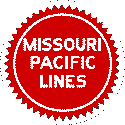|
|||||
| HOME Power Cabooses Rolling Stock MoW Depots | |||||
Workin'
on the Railroad
Every railroad has to mantain the line 24/7 - this task falls to the Mantainence-of-Way crew also known as the "Gang." We will always continue to add more stories as told by former employees of the Missouri Pacific, and any interesting information we come across.

|
|
First in order: a short description of the duties of the MoW Gang. Foreman/Gang Boss - he's just what the name says Section Gang - Section Crews or Section Gangs as they were commonly known, were responsible for a (large) section of track. They typically rode handcars (later motorcars) to look for and replace bad ties, tamp loose spikes, and tighten bolts. Extra Gang - The crew of track laborers assigned to maintenance work at various points on a railroad right-of-way. These employees may live in camp (bunk) cars where they are provided lodging and meals at a nominal cost.
More terms: B&B - Bridge and Building department Boomer - Itenerent railroad workers, always moving from one location to another. Dozer - Bulldozer operator. Gandy Dancer - A track worker assigned to work on an extra-gang. The name came from the Gandy Manufacturing Company in the 1800's who made many of track tools. Snipe - Track worker (section laborer). |
|
|
|
Tools of the Trade
Spike Driver - A sledge hammer, but designed with a longer, slimmer head to specifically seat spikes up against a section of rail. Tie Tongs - Large tool, looking much like ice-tongs, used by workers to drag or carry individual cross ties.
Power tools: Rail or Track Saw - large circular saw (replaced simpler hand-held saws) used to size individual sections of rail to fit into track.
Hardware: Cross Tie - usually made of creosote treated lumber about 6'-8' long, but today concrete ties are becoming an increasingly popular alternative. Rail Bolt - Used with rail plates to join sections of rail together. Rail Clip - Placed under rail on either side of a cross tie to keep it from "wandering" over time. Spike - Large nail driven through tie plate into cross tie used to hold rail sections in place. Tie Plate - Placed between rail and cross tie, helps to keep spikes from becoming loose and crosstie from splitting. Rail Section- Heavy section of iron that provides the actual "wheel to iron" surface of the railroad track. Rail Bar - joiner bar inserted where rail sections join together, and bolted through both sections of rail. Welded Rail - Long
continous section of rail which requires no bolting together. Welds are
used where the long sections meet.
|
![]()
|
MPRR
Employee Feature Pages
- Input from all former-MPRR Employees welcome!
|
||||
Special Thanks to All the Former Missouri Pacific RR
Engineers and Employees
who have contributed their lives to the Railroad and their unique knowledge
to this site:
James Blagg MPRR Telegrapher-clerk, Concordia and Omaha Sub's, 1973-1987
Bob Currie MPRR Engineer DeQuincy Division, 1972-1990 (engineer 1973-1990)
Daryl W. Favignano MPRR Mechanical Engineering Dept. at St Louis, 1974-1986
Jay Glenewinkel MPRR/UPRR Crew Van Driver, 1992-1997
Nathan Griffin MPRR/UPRR, Hoskins Junction, Clute, Texas, 1975-Today
JD "Tuch" Santucci MPRR Engineer, Dolton and Villa Grove, IL , 1978-1985
Recommended Websites operated by former MPRR Employees:
Bob Currie's MISSOURI PACIFIC DeQuincy Division - MP Engineer
Hot Times
on the High Iron by "Tuch" Santucci - MP Engineer
Missouri
Pacific Railroad Memories by C.E. "Cliff" Satterfield - MP Superintendent
B.M.W.E.
Union, Lodge # 0455/Missouri Pacific System Federation
|
MPRR Employees Service Forum - Devoted to sharing information of former MoPac employees. Feel free to post names or information of those who worked on the railroad -- former MP Employees are Welcome! |
Help Save Lives
Operation
Lifesaver
Railroad
Clipart courtesy of
The Ultimate Railroad
Clip Art Library
| All images & text © 2000-2008 T. Greuter / Screaming Eagles, unless otherwise noted. All Rights Reserved. | |